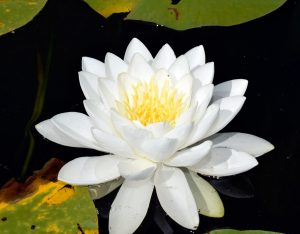American White Water Lily
 Nymphacea odorata, is so named because of the enticing fragrance of these flowers with their short, 3-day bloom cycle. For me, one whiff brings to mind rich memories of swimming and boating among these lovely aquatic plants. Closing at noon and opening again at dawn, the radiant, pure white petals appear almost mandala-like. They surround a large cluster of yellow stamens that tremble at the slightest motion as if to catch your attention and say, “Come look at me”. Indeed, of course that is the point!
Nymphacea odorata, is so named because of the enticing fragrance of these flowers with their short, 3-day bloom cycle. For me, one whiff brings to mind rich memories of swimming and boating among these lovely aquatic plants. Closing at noon and opening again at dawn, the radiant, pure white petals appear almost mandala-like. They surround a large cluster of yellow stamens that tremble at the slightest motion as if to catch your attention and say, “Come look at me”. Indeed, of course that is the point!
Those flexible stamens have a role to play in a fascinating drama of avoiding self-pollination. Below the stamens, a pool of viscous liquid in the shape of a bowl awaits with the receptive stigma of the female structure ripe and ready at the bottom. On the first day the lily opens — sending a luscious fragrance advertising its nectar out into the world — only the female parts are mature. The stamens on this first day aren’t yet producing any pollen. The generous supply of nectar, however, attracts a wide variety of insects to land on the wiggly flower stamens. A heavy insect may easily fall through into the pool below, sink to the bottom, and in the process wash off any pollen brought in from another flower. In this way, the insect accomplishes the flower’s goal of cross-pollination.
Act II finds the hapless insect spending quite some time down there struggling to swim out again. It doesn’t help that the flower closes at night for an extra measure of entrapment. In the morning, hopefully the insect can remove itself again to pollinate another flower (from the lily’s point of view) or replenish itself with more nectar and pollen (from the insect’s point of view). By daybreak of the second morning, the male anthers have matured and are now pollen producers, easily depositing a load onto the departing insect. The stigma of the female parts are no longer receptive, and the stigmatic fluid dries up. The pollen produces for 2 days out of the 3, and then the flower closes up and, if fertilized, submerges.
As you swim or boat through these gorgeously large and hefty blooms, take note of the stylish way some of the stems appear to corkscrew down through the the water. They are doing this for a reason. When a flower has been fertilized, the corkscrew action of the stem slowly draws the flower (and thus the ovaries) back down several inches below the water’s surface into the protection of underwater where the seeds then develop. Meanwhile, other flowers float on the surface awaiting their turn at fertilization. Four green sepals act like curtains, releasing themselves to draw open and reveal the flower by day, then pulling closely round it protectively at nighttime.
Water lilies belong were one of the first flowering plants millions of years ago, and are termed ‘angiosperms’ (“vessel-protected seed”). The first angiosperms relied on beetles for pollination. Since beetles are poor and clumsy fliers while others are flightless, the flowers evolved designs to best attract them. Agile flying insect pollinators that we’re more familiar with like bees, moths and butterflies were still millions of years from existence. As a consequence, water lilies and other ancient lineages (such as magnolia) developed flowers that are wide and easily accessible.
Leaves are classic water lily shape — round and flat with a deep slit at the base and floating upon the surface of the water. Mammals who love the delicious leaves and roots include deer, muskrats, beaver, moose, raccoons and porcupines. Water fowl eat the seeds, and the leaves provide shelter and habitat for frogs, dragonflies and fish.
This native water flower is an iconic sight out on any Minnesota lake starting in June and lasting into September.

